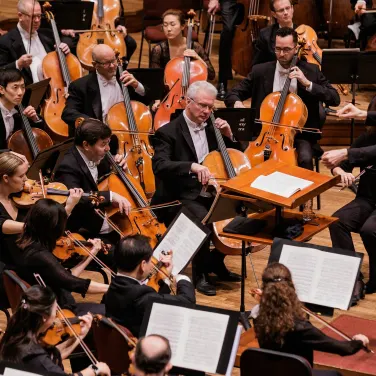
About
The National Symphony Orchestra is an American symphony orchestra based in Washington, D.C. Founded in 1930 by cellist Hans Kindler, its principal performing venue is the John F. Kennedy Center for the Performing Arts. Read more on Last.fm
Genres
- orchestra
- orkiestra symfoniczna
- radio symphony
Frequently Asked Questions
- How much do members of the National Symphony Orchestra make?
- Members of the National Symphony Orchestra earn competitive salaries that reflect their skill, experience, and the prestigious reputation of the ensemble. As of recent reports, base salaries for National Symphony Orchestra musicians typically range from $70,000 to $150,000 per year, depending on their position and tenure. Principal musicians and section leaders often command higher salaries, while rank-and-file musicians receive the base pay. In addition to base salary, musicians may receive additional compensation for overtime, special performances, and other engagements. The orchestra is committed to maintaining high compensation standards to attract top talent and ensure artistic excellence. Benefits such as health insurance, retirement plans, and paid leave are also part of the compensation package, contributing to the overall value of employment. These factors make the National Symphony Orchestra a highly desirable employer for classical musicians. The orchestra's salaries are in line with other major U.S. symphony orchestras, reflecting its status in the classical music world.
- Where does the National Symphony Orchestra perform?
- The National Symphony Orchestra primarily performs at the John F. Kennedy Center for the Performing Arts in Washington, D.C., which serves as its official home. The Kennedy Center is a world-renowned venue that offers state-of-the-art acoustics and facilities, making it ideal for symphonic performances. The orchestra's concerts are typically held in the Concert Hall, the largest performance space within the Kennedy Center, which can accommodate over 2,400 attendees. In addition to its regular season at the Kennedy Center, the National Symphony Orchestra also participates in special events, pop concerts, community outreach performances, and national tours. Occasionally, the orchestra performs at other prestigious venues across Washington, D.C., and the United States, further expanding its reach and influence. Whether at the Kennedy Center or on tour, the National Symphony Orchestra provides audiences with exceptional classical music experiences in world-class settings.
- What are the big 5 orchestras in the US?
- The "Big 5"
- Do Kennedy Center performers get paid?
- Yes, performers at the Kennedy Center, including those from the National Symphony Orchestra and visiting artists, are compensated for their performances. Payment amounts can vary widely depending on the artist's status, the nature of the event, and the terms of their contracts. For National Symphony Orchestra members, performance payments are typically included as part of their annual salary and may be supplemented for special events or additional services. Guest artists, soloists, and touring performers negotiate fees based on their experience and the scope of the engagement. The Kennedy Center is a world-class performing arts venue, and it maintains professional standards regarding artist compensation. In addition to payment, artists may also receive benefits such as accommodations, travel expenses, and per diem allowances, especially for those coming from outside the Washington, D.C. area. This commitment to fair compensation ensures that the Kennedy Center attracts leading talent from around the world.
- Who funds the National Symphony Orchestra?
- The National Symphony Orchestra is funded through a combination of sources that ensure its continued success and artistic excellence. Primary funding comes from ticket sales, subscriptions, and performance revenues. However, these typically cover only a portion of the orchestra's operating expenses. Significant additional support is provided by private donations from individuals, foundations, and corporations who value the orchestra's cultural contributions. The Kennedy Center, as the orchestra's home, also provides financial and logistical support for its operations. Government grants, including funding from the National Endowment for the Arts and local arts councils, further supplement the orchestra's budget. Special fundraising events, sponsorships, and endowment income play crucial roles in supporting educational programs, community outreach, and new artistic initiatives. This diverse funding model enables the National Symphony Orchestra to maintain high artistic standards, offer accessible programming, and foster the growth of classical music in Washington, D.C., and beyond.